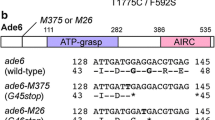Abstract
Collection of missense mutations in the SUP45 gene of Saccharomyces cerevisiae encoding translation termination factor eRF1 has been obtained by different approaches. It has been shown that most of isolated mutations cause amino acid substitutions in the N-terminal part of eRF1 and do not decrease the eRF1 amount. Most of mutations studied do not abolish eRF1–eRF3 interaction. The role of the N-terminal part of eRF1 in stop codon recognition is discussed.
Similar content being viewed by others
REFERENCES
Frolova, L., Le Goff, X., Rasmussen, H.H., et al., A Highly Conserved Eukaryotic Protein Family Possessing Properties of Polypeptide Chain Release Factor, Nature, 1994, vol. 372, pp. 701-703.
Stansfield, I., Jones, K.M., Kushnirov, V.V., et al., The Products of the SUP45 (eRF1) and SUP35 Genes Interact to Mediate Translation Termination in Saccharomyces cerevisiae, EMBO J., 1995, vol. 14, pp. 4365-4373.
Zhouravleva, G., Frolova, L., Le Goff, X., et al., Termination of Translation in Eukaryotes Is Governed by Two Interacting Polypeptide Chain Release Factors, eRF1 and eRF3, EMBO J., 1995, vol. 14, pp. 4065-4072.
Milman, G., Goldstein, J., Scolnick, E., and Caskey, T., Peptide Chain Termination: 3. Stimulation of in Vitro Termination, Proc. Natl. Acad. Sci. USA, 1969, vol. 63, pp. 183-190.
Ito, K., Ebihara, K., Uno, M., and Nakamura, M., Conserved Motifs in Prokaryotic and Eukaryotic Polypeptide Release Factors: tRNA-Protein Mimicry Hypothesis, Proc. Natl. Acad. Sci. USA, 1996, vol. 93, pp. 5453-5458.
Ito, K., Uno, M., and Nakamura, Y., A Tripeptide “Anticodon” Deciphers Stop Codons in Messenger RNA, Nature, 2000, vol. 403, pp. 680-684.
Vestergaard, B., Van, L.B., Andersen, G.R., et al., Bacterial Polypeptide Release Factor RF2 Is Structurally Distinct from Eukaryotic eRF1, Mol. Cell, 2001, vol. 8, pp. 1375-1382.
Rawat, U.B., Zavialov, A.V., Sengupta, J., et al., A Cryo-Electron Microscopic Study of Ribosome-Bound Termination Factor RF2, Nature, 2003, vol. 421, pp. 87-90.
Bertram, G., Bell, H.A., Ritchie, D.W., et al., Terminating Eukaryote Translation: Domain 1 of Release Factor eRF1 Functions in Stop Codon Recognition, RNA, 2000, vol. 6, pp. 1236-1247.
Chavatte, L., Seit-Nebi, A., Dubovaya, V., and Favre, A., The Invariant Uridine of Stop Codons Contacts the Conserved NIKSR Loop of Human eRF1 in the Ribosome, EMBO J., 2002, vol. 21, pp. 5302-5311.
Inge-Vechtomov, S.G. and Andrianova, V.M., Recessive Super-Suppressors in Yeasts, Genetika (Moscow), 1970, vol. 6, pp. 103-115.
Zakharov, I.A., Kozhin, S.A., Kozhina, T.N., and Fedorova, I.V., Sbornik metodik po genetike drozhzhei-sakharomitsetov (Methods of the Genetics of Saccharomycetes), Leningrad: Nauka, 1984.
Sherman, F., Fink, G.R., and Hincks, J.B., Methods in Yeast Genetics, Cold Spring Harbor, New York: Cold Spring Harbor Lab., 1986.
Gietz, D., St. Jean, A., Woods, R.A., and Schiestl, R.H., Improved Method for High Efficiency Transformation of Intact Yeast Cells, Nucleic Acids Res., 1992, vol. 20, pp. 1425-1431.
Fields, S. and Song, O., A Novel Genetic System to Detect Protein-Protein Interactions, Nature, 1989, vol. 340, pp. 245-246.
Feilotter, H.E., Hannon, G.J., Ruddell, C.J., and Beach, D., Construction of an Improved Host Strain for Two-Hybrid Screening, Nucleic Acids Res., 1994, vol. 22, pp. 1502-1503.
Le Goff, X., Philippe, M., and Jean-Jean, O., Overexpression of Human Release Factor 1 Alone Has an Anti-suppressor Effect in Human Cells, Mol. Cell. Biol., 1997, vol. 17, pp. 3164-3172.
Cosson, B., Couturier, A., Chabelskaya, S., et al., Poly(A)-Binding Protein Acts in Translation Termination via Eukaryotic Release Factor 3 Interaction and Does Not Influence [PSI +] Propagation, Mol. Cell. Biol., 2002, vol. 22, pp. 3301-3315.
Moskalenko, S.E., Chabelskaya, S.V., Inge-Vechtomov, S.G., et al., Viable Nonsense Mutants for Essential Gene SUP45 of Saccharomyces cerevisiae, BMC Mol. Biol., 2003, vol. 4,no. 2.
Didichenko, S.A., Ter-Avanesyan, M.D., and Smirnov, V.N., Ribosome-Bound EF-1α-like Protein of Yeast Saccharomyces cerevisiae, Eur. J. Biochem., 1991, vol. 198, pp. 705-711.
Laemmli, U.K., Cleavage of Structural Proteins during the Assembly of the Head of Bacteriophage T4, Nature, 1970, vol. 227, pp. 680-685.
Towbin, H., Staehelin, T., and Gordon, J., Electrophoretic Transfer of Proteins from Polyacrylamide Gels to Nitrocellulose Sheets: Procedure and Some Applications, Proc. Natl. Acad. Sci. USA, 1979, vol. 76, pp. 4350-4354.
Breining, P. and Piepersberg, W., Yeast Omnipotent Suppressor SUP1 (SUP45): Nucleotide Sequence of the Wild-Type and a Mutant Gene, Nucleic Acids Res., 1986, vol. 11, pp. 5187-5197.
Mironova, L.N., Samsonova, M.G., Zhouravleva, G.A., et al., Reversions to Respiratory Competence of Omnipotent sup45 Suppressor Mutants May Be Caused by Secondary sup45 Mutations, Curr. Genet., 1995, vol. 27, pp. 195-200.
Beier, H. and Grimm, M., Misreading of Termination Codons in Eukaryotes by Natural Nonsense Suppressor tRNAs, Nucleic Acids Res., 2001, vol. 29, pp. 4767-4782.
Song, H., Mugnier, P., Das, A.K., et al., The Crystal Structure of Human Eukaryotic Release Factor eRF1: Mechanism of Stop Codon Recognition and Peptidyl-tRNA Hydrolysis, Cell (Cambridge, Mass.), 2000, vol. 100, pp. 311-321.
Frolova, L.Y., Tsivkovskii, R.Y., Sivolobova, G.F., et al., Mutations in the Highly Conserved GGQ Motif of Class 1 Polypeptide Release Factors Abolish the Ability of Human eRF1 to Trigger Peptidyl-tRNA Hydrolysis, RNA, 1999, vol. 5, pp. 1014-1020.
Ito K., Ebihara, K., and Nakamure, Y., The Stretch of C-Terminal Acidic Amino Acids of Translational Release Factor eRF1 Is a Primary Binding Site for eRF3 of Fission Yeast, RNA, 1998, vol. 4, pp. 958-972.
Cox, B.S., Allosuppressors in Yeast, Genet. Res., 1977, vol. 30, pp. 187-205.
Author information
Authors and Affiliations
Rights and permissions
About this article
Cite this article
Moskalenko, S.E., Zhouravleva, G.A., Soom, M.Y. et al. Characterization of Missense Mutations in the SUP45 Gene of Saccharomyces cerevisiaeEncoding Translation Termination Factor eRF1*. Russian Journal of Genetics 40, 478–484 (2004). https://doi.org/10.1023/B:RUGE.0000029148.58151.91
Issue Date:
DOI: https://doi.org/10.1023/B:RUGE.0000029148.58151.91



